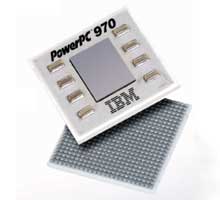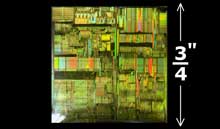Processors
Links to topics on this page:
The microprocessor is the component of the personal computer that does the actual processing of data. A microprocessor is a central processing unit (CPU) that fits on one microchip. It is the “brain” of the computer, but that is a rather pretentious term since it it really just a very complex switching circuit that executes simple instructions very rapidly.
Clock Speed
CPU Speed
Cache
Types of CPUs
Data Bus
The microprocessor integrated circuit package holds a silicon chip that contains millions of transistors and other components fabricated into the silicon. Because the transistors on the chip are very tiny, even a small zap of high voltage current (such as from static electricity) can destroy a chip. This is why all large-scale integrated circuits must be handled in ways that minimize the possibility of static electric discharge.
Because of the large amount of circuitry packed into such a tiny area, microchips produce a lot of heat and they require cooling systems to keep the chip from overheating. On computer motherboards the CPU chip is covered by a large metal heat sink with “fins” to allow airflow from cooling fans to carry the heat away.
Clock Speed
The digital chips on a motherboard are keep in sync with each other by the clock signal (a stream of pulses) of the motherboard. You can think of it like a “heartbeat” of the computer. The faster the clock pulses, the faster the computer runs; but, the clock can’t run faster than the speed rating of the chips, or they will “glitch” and drop data. As chip technology has improved, the speed that chips can run at has gotten faster. The CPU runs faster than the rest of the motherboard (which is clocked at a fraction of the rate of the CPU).
Clock speed is measured in units of cycles per second, which is called a Hertz (Hz). Computer boards and CPUs run at rates of millions and billions of Hertz, megahertz (MHz) and gigahertz (GHz). A good speed for a PC microprocessor in 2004 was 4 GHz. You will want a fast processor, of course, but so does everyone else—and only a fraction of the chips produced in a batch are the fastest (they are all tested and rated after fabrication)—so faster CPUs cost more.
You may recognize the terms megahertz and gigahertz from radio broadcasts. FM radio and TV broadcast in the MHz range, and some mobile phones broadcast in the GHz range. So, computer circuitry produces radio frequency interference that could cause problems for nearby devices. To prevent this, a computer contains thin metal shielding inside its case (if the case is not metal).
CPU Speed
Clock speed is only one aspect that contributes to the overall processing speed of a microprocessor. The architecture of the chip also is a factor. This includes such considerations as the word size of the chip, which is how many bits it can input/output and process at a time. Early microprocessors used 8-bit word size; the newest microprocessors use 64-bit word size.
The design of the chip may also include high speed cache memory that the processor can use to hold recently used instructions or data in case it needs them again, so that it doesn’t need to go back to the much slower main RAM memory to get them. Computers spend a lot of time in loops, repeating the same sequence of instructions, so this can greatly improve performance. (Depending on whether the cache memory is located on the CPU chip itself, or on a nearby chips with a high-speed link, it is called Level 1 or Level 2 cache).
Other aspects of chip architecture that affect speed include the ability of some CPUs to work on multiple instructions at the same time. Also, some CPUs are CISC (Complex Instruction Set Computing), while others are RISC (Reduced Instruction Set Computing). RISC chips have a smaller set of simpler instructions; they need multiple instructions to perform an action that a CISC chip does with one instruction, but the RISC chip is faster overall at completing the operation.
The result is that you can’t simply compare different processors by looking at their clock speed ratings. A PowerPC chip with half the clock speed of a Pentium has roughly equivalent processing speed.
Types of Microprocessors

IBM PowerPC processor (G5) showing top and bottom.
The most commonly used CPU in PCs are made by Intel. Since IBM chose the Intel 8088 chip for the original IBM PC, most PC clones have used one of the Intel series of CPUs:
8088 - used in IBM PC
80286 - used in IBM PC AT
80386 - used in first PC clone from Compaq
80486
- you heard phrases like “I have a 486 PC”
Pentium - Intel couldn’t trademark a number, such as 80586
Pentium II - (Hexium or sexium just wouldn’t sound right)
Pentium III
Pentium 4 - Most desktop PCs in 2004 used the P4 chip.
Another manufacturer of microprocessors for the PC is AMD (Advanced Micro Devices, Inc.). Their line of Athlon processors have been successful in taking a substantial fraction of the PC CPU market away from Intel.
The Macintosh series of computers from Apple originally used the Motorola 68000 series of microprocessors. The Motorola CPUs use a different instruction set than Intel CPUs, which is why you couldn’t easily run PC software on a Mac and vice versa (but transferring data files is no problem). Apple later used the RISC PowerPC CPU (developed jointly by Apple, Motorola, and IBM). New Macs in 2004 used either PowerPC G4 chips from Motorola, or the newer PowerPC G5 from IBM. As of 2006, Apple switched to using Intel processors in their new Macs (which then made it possible to run Windows software directly on the Mac).
Data Bus
The data bus is the multi-lane electrical highway of connections that link the CPU to the other chips on the motherboard, such as the RAM memory and I/O controllers. It is also called the front side bus (FSB). The word size of the data bus determines how many bits can be moved simultaneously along it.
The clock speed of the other chips on the data bus (of the motherboard as a whole), is slower than the clock speed of the CPU (typically in the hundreds of MHz).
